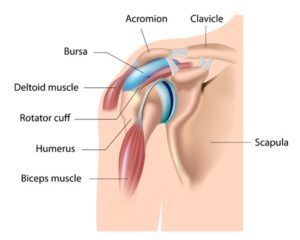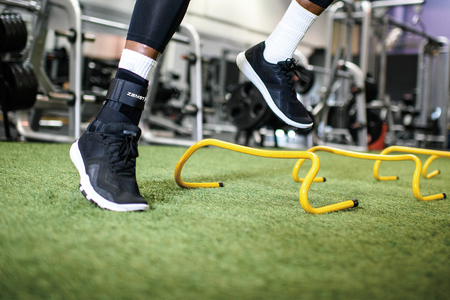The shoulder is a ball-and-socket joint made up of three bones: the upper arm bone (humerus), shoulder
 blade (scapula), and the collarbone (clavicle). Within the shoulder is the labrum, which is a circular ring-like cartilage that sits inside the socket of the shoulder joint. The shoulderlabrum acts as a small suction cup providing a small amount of stability to the shoulder joint as well as acting as a cushion pad between the arm bone and shoulder blade as you twist, reach, and extend the arm. A SLAP tear is commonly associated to an injury to the upper portion of the labrum in the shoulder.
blade (scapula), and the collarbone (clavicle). Within the shoulder is the labrum, which is a circular ring-like cartilage that sits inside the socket of the shoulder joint. The shoulderlabrum acts as a small suction cup providing a small amount of stability to the shoulder joint as well as acting as a cushion pad between the arm bone and shoulder blade as you twist, reach, and extend the arm. A SLAP tear is commonly associated to an injury to the upper portion of the labrum in the shoulder.Type 1: Tearing/fraying of upper portion of labrum with no biceps involvement
*Type 3: Detachment of upper portion of labrum with no biceps involvement
*Type 4: Detachment of upper portion of labrum with part of the biceps involvement* Detachment of the labrum is also commonly called: “bucket handle tears”
● Falling onto an outstretched arm while diving to catch the ball or sliding to plate.
Treatment:
Non-surgical – Physical therapy is a common conservative method in conjunction with non-steroidal anti-inflammatory drugs like ibuprofen. Physical therapy addresses overall shoulder functionality by focusing on strength and flexibility of rotator cuff muscles and surrounding shoulder muscles as well as overall shoulder mechanics.
Surgical – Typically, surgical treatment involves fairly less invasive procedure with several small incisions around the shoulder. The labrum will be shaved and removed or stitched back into the socket depending on severity of the injury. There are many approaches to treating a SLAP and a conversation with the surgeon will allow better understanding of which option to pursue.
Prevention:
Maintaining proper muscular flexibility, joint flexibility, and shoulder blade/scapular stability can help reduce risk of injury or re-injury. “Thrower’s Ten”, a shoulder stability program has shown significant results in ability to return to sport as well as improving overall baseball pitches by 2 mph after 6 weeks of diligently sticking to the program.
– Link with instructions and photos to “Thrower’s Ten program” http://www.muhlenberg.edu/media/contentassets/pdf/athletics/athletictraining/throwers10.pdf
References:
- Wilk KE, Macrina LC, Cain EL, Dugas JR, Andrews JR. Rehabilitation of the Overhead Athlete’s Elbow. Sports Health. 2012;4(5):404-414. doi:10.1177/1941738112455006.
- Yang, J., Mann, B. J., Guettler, J. H., Dugas, J. R., Irrgang, J. J., Fleisig, G. S., & Albright, J. P. (2014). Risk-Prone Pitching Activities and Injuries in Youth Baseball: Findings From a National Sample. The American Journal of Sports Medicine,42(6), 1456-1463. doi:10.1177/0363546514524699
- Teng, S., PT, PhD. (n.d.). Overhead Throwing. Lecture presented in CSULB, Long Beach
Victor Nguyen, SPT
3rd year DPT Program
California State University, Long Beach







1 comment
That’s way the beestst answer so far!